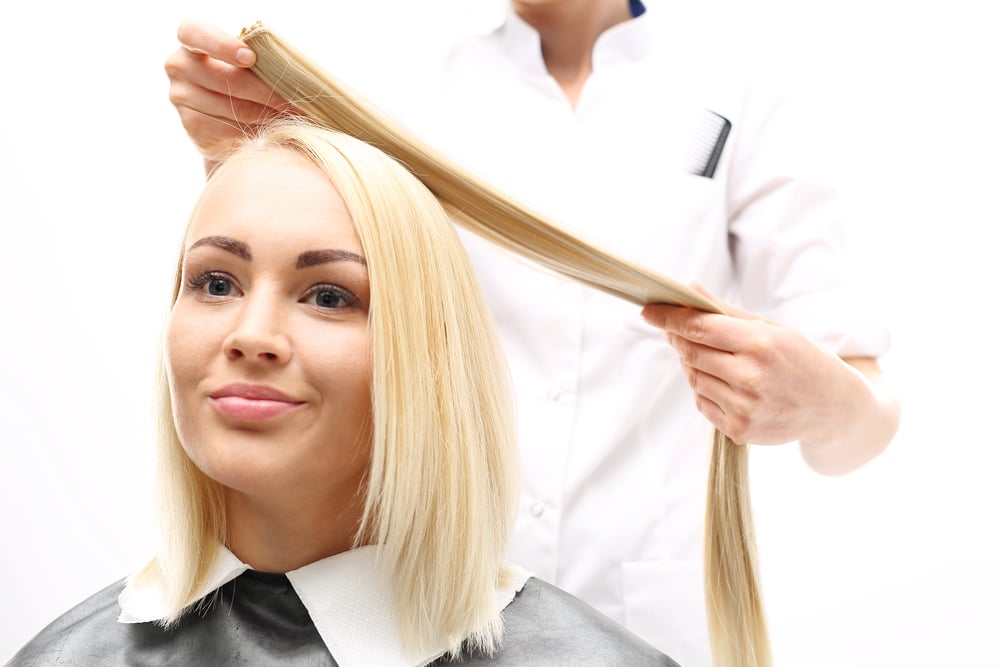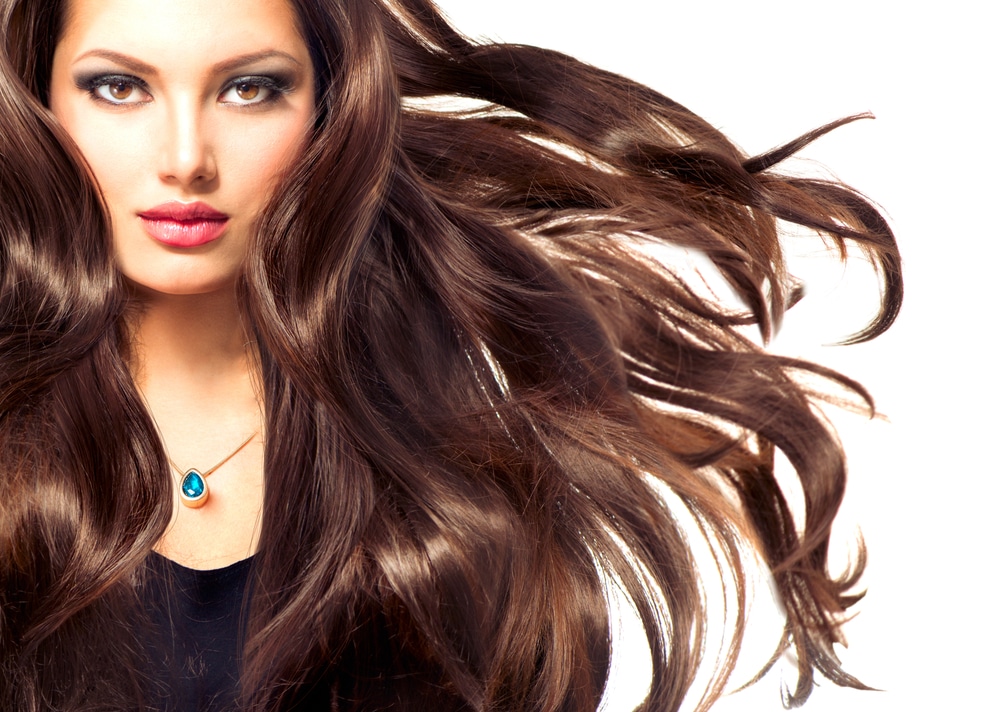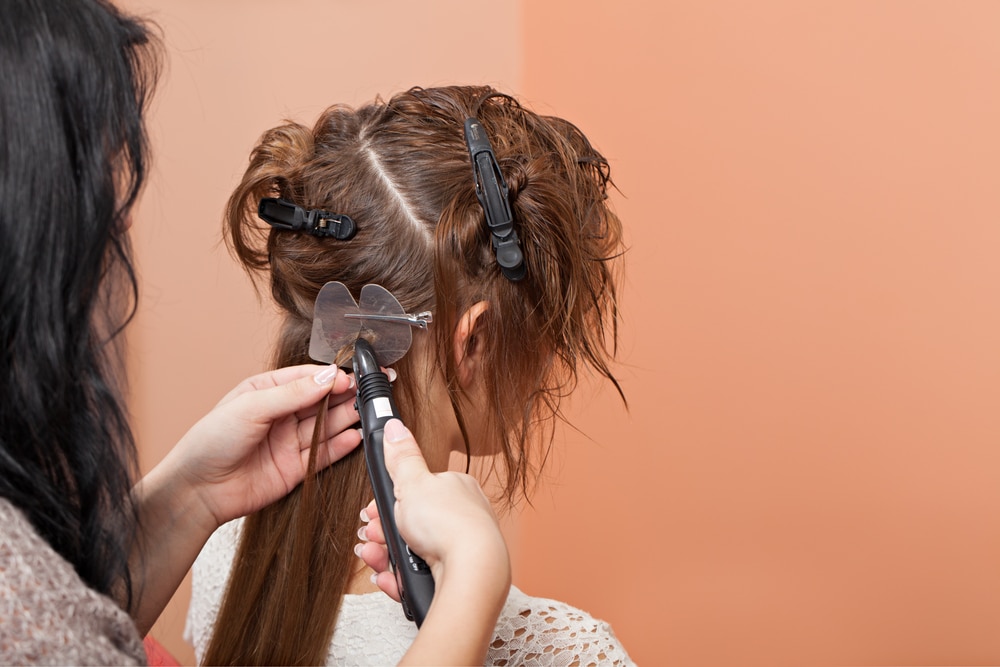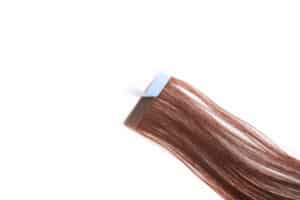Our website is supported by our users. This site contains affiliate links. If you click such a link and make a purchase, we may earn a commission for our endorsement, recommendation, testimonial, and/or link to any products or services from this website. Contact us for Questions

How Do Hair Extensions Work? A Comprehensive Guide
Hair extensions work by adding length, volume, or a pop of color to your locks.
Understanding how hair extensions work can help you make a smart decision about using them in your beauty routine. Below, we’ll explore the types of extensions, how they’re applied, and much more.

Hair extensions offer a solution if you’re looking to quickly transform your hairstyle. These hair enhancements come in different materials. From synthetic to real human hair, they can be tailored to your preferences and budget.
A number of application methods are available. These include clip-in, tape, weft bundles, and keratin extensions. Each offers unique benefits and levels of commitment.
As you navigate the world of hair extensions, know that finding the right type and application method for your lifestyle and hair condition is key to getting the desired results. Take the time to research and consult with a professional hairstylist so you make the best choice for your hair and style goals.
How Do Hair Extensions Work? The Basics of Extensions
Types of Hair Extensions
There are several types of hair extensions that you can choose from to enhance your look:
- Clip-in extensions: These are wefts of hair attached to small combs that can be easily clipped into your natural hair in sections. They offer a temporary way to add length and volume to your hair without any long-term commitment.
- Tape-in extensions: These extensions are pre-taped and then applied to your natural hair using heat to bond the adhesive. They require professional installation and removal, and can be reused multiple times with proper care.
- Sew-in or weave extensions: Ideal for those with thicker hair. This method involves braiding your natural hair to create a base where the hair extensions are sewn in. This requires a professional stylist for best results.
- Beaded rows: This method uses small beads to attach the extension hair to your natural hair. The beads are tightened to secure the extensions and can be adjusted as your hair grows.
- Halo extensions: These are a temporary hair extension option that involves a clear wire and hair weft that sits on top of your head like a halo. The wire is hidden under your natural hair, and there’s no need for any clips or adhesives.
- Microlinks: Also called micro bead or I-tip extensions, this method involves attaching the extensions to your natural hair using small metal beads that are clamped down. Microlinks avoid heat or glue, and provide a more natural-looking result.
What Are Hair Extensions Made Out Of?
Hair extensions are made from two primary materials:
Human Hair
This is the most natural-looking option as it’s made from real human hair. It can be styled just like your own hair with heat tools and holds curls and styles better. However, it can be more expensive than synthetic hair.
Synthetic Hair
These are made from artificial materials like polyester or acrylic. Synthetic hair can be a budget-friendly alternative to human hair. While they can’t be styled with heat tools, advancements in technology have led to improvements in the quality and appearance of synthetic hair extensions.
How Do Hair Extensions Work with Short Hair?
Hair extensions can work wonders for those with short hair, enhancing length and volume, provided you choose the right type and method. First, determine the extension length that would suit your existing hair length. For short hair, extensions between 16 and 18 inches are preferable. But if your hair is shorter than chin length, you may opt for even shorter extensions.
When it comes to types of hair extensions, clip-in extensions are easier to blend with short hair. To install them, divide your hair at the occipital area, clip the top layer up, clip in your extensions, and proceed with styling and blending. This technique creates a natural look while preserving the hair’s health.
Remember that adding volume to short hair can also be achieved through extensions. In this case, apply a small number of extensions with the same length as your hairstyle to thicken your locks.
As a helpful tip, select extensions made from natural human hair, as they’re easier to blend, style, and maintain. Bear in mind that the right shade of extensions is crucial for a seamless appearance. For this reason, choose a hue that matches your natural hair or opt for one that complements it.
Finally, ensure that you properly maintain your hair extensions. Frequent washing can shorten their lifespan, so washing every 15 to 20 wears is recommended. When styling your extensions, use heat protectant spray and avoid high heat settings on styling tools. Regularly brush your extensions gently to prevent knots and prolong their life.
How Do Hair Extensions Work for Thin Hair?
Hair extensions can be a game-changer for those with thin hair. They add length, volume, and even color to your natural hair, giving you a fuller, more vibrant appearance. In this section, we will discuss how hair extensions work for thin hair and some tips on choosing the best type for your specific needs.
First, let’s explore the most common types of hair extensions suitable for thin hair. Clip-in extensions are a popular choice because they are easy to apply and remove. To use them, you simply attach the clips to the roots of your hair, ensuring the extensions blend seamlessly with your natural locks. These extensions are ideal for those who want a temporary solution for added volume or length on special occasions.
Another option is tape-in extensions. These are semi-permanent and involve attaching thin, adhesive strips to your hair. The extensions are then sandwiched between your natural hair strands and lay flat against your head, minimizing the appearance of the extensions. Tape-in extensions can last for up to eight weeks, but they require regular maintenance to ensure they stay in place.
For those who prefer a more long-lasting solution, microlink extensions may be a good fit. Microlink extensions involve attaching tiny beads or links to your hair, which are then clamped onto the extensions. This method offers a secure attachment and allows for more natural hair movement. However, microlinks may not be suitable for extremely thin hair, as the beads can be visible if not placed correctly.
When choosing hair extensions for thin hair, it’s important to consider the following factors:
- Hair type: Make sure the extensions match your natural hair texture, whether it’s straight, wavy, or curly. This helps them blend seamlessly and look more natural.
- Color: Matching the color of your extensions to your natural hair is crucial for a cohesive appearance. It may be helpful to consult with a professional to ensure the best color match.
- Weight: Opt for lightweight extensions to avoid putting too much stress on your natural hair, which can lead to more hair loss or damage.
- Placement: To achieve a natural and blended look with hair extensions, strategically placing them on your head is crucial. Work with a professional to ensure seamless integration with your natural hair.
Do You Treat Hair Extensions Just Like Your Own Hair?

When it comes to hair extensions, you might wonder if they require the same care as your natural hair. The answer is yes, but with some slight modifications. To ensure your extensions last as long as possible, it’s essential to follow a proper care routine.
Firstly, regular brushing prevents tangling and helps maintain a smooth look. Use a wide-tooth comb or a brush specially designed for extensions, starting at the ends and gradually moving up towards the roots. Be gentle and avoid tugging or pulling too hard.
You can wash your hair extensions, but do it less frequently than your own hair. Aim for every 15-20 wears or when there’s a noticeable buildup of product. Use mild, sulfate-free shampoos and conditioners to avoid damage or dryness. When washing, focus on the roots and gently work your way down, avoiding vigorous rubbing.
It is also essential to consider how you dry your extensions. Pat them gently with a towel, and don’t wring or twist them. Allow air drying or use the lowest heat setting on your hairdryer if you’re in a hurry. Keep in mind that using excessive heat can cause damage to the extensions.
When it comes to styling, treat your hair extensions with care. Avoid using high heat tools, such as curling irons and straighteners, too frequently. When necessary, use a heat protectant and opt for lower heat settings. Remember that your extensions may not handle heat as well as your natural hair, so being cautious is essential.
Finally, be mindful when sleeping with your hair extensions. It’s best to put them into a loose braid or a silk or satin bonnet to protect them from friction and potential damage. This step will also ensure your extensions stay smooth and tangle-free.
How Do You Get Hair Extensions To Blend With Your Natural Hair?
Blending hair extensions with your natural hair is essential for achieving a seamless and natural look. In this section, we will discuss three key aspects: color, length, and style. Paying attention to these details will help you get the perfect blend.
Color
Choosing the right color for your hair extensions is crucial to make them blend well with your natural hair. Follow these tips to get the best match:
- Select extensions that are closest to your natural hair color.
- If you have highlights or lowlights, opt for extensions with similar tones to create a multidimensional look.
- If you’re unsure about the color, consult a professional hair stylist for advice.
Length
To achieve the best blend, consider the length of your hair extensions:
- Extensions should complement your natural hair length and your desired look.
- For short hair, choose extensions that are at least 2-3 inches longer than your own hair to create a seamless transition.
- For long hair, select extensions of various lengths to create layers and avoid a blunt appearance.
Style
The way you style your hair extensions can also affect how well they blend with your natural hair:
- Curl or wave your extensions before clipping them in to create a cohesive look.
- Use a flat iron or curling wand to give your hair and extensions a similar texture.
- Once your extensions are in place, style your hair as usual, incorporating both your natural hair and extensions in the process.
Can Extensions Damage Your Hair?
Yes, hair extensions can potentially damage your hair if not installed, maintained, or removed properly. It is crucial to be aware of the risks and take appropriate precautions to minimize damage to your natural hair.
One of the primary causes of damage is tension. Traction alopecia can result from tightly installed hair extensions that put excessive strain on your hair roots. To avoid this, ensure that your extensions are not installed too tightly. If you experience pain or discomfort during the installation process, be sure to speak up!
Another potential risk is the application method. Some permanent hair extension techniques, such as glue or bonding, may cause damage to the roots of your hair. It’s essential to choose a method that is less likely to cause damage like clip-ins or halo extensions, as they put less strain on your hair.
Furthermore, proper maintenance of your hair extensions is crucial to prevent damage:
- Brush your hair gently and regularly to avoid tangles and matting.
- Use sulfate-free and alcohol-free hair products, as they can be gentler on both your natural hair and extensions.
- Avoid excessive use of heat styling tools, as they can cause damage and weaken your hair.
How Long Do Extensions Last?
Hair extensions can be a fantastic way to change up your look, but one of the key questions is how long they last. The lifespan of hair extensions depends on the type, quality, and how well you take care of them.
With proper maintenance, most hair extensions can last for 10-12 weeks at a time. However, it’s important to note that they may occasionally slip out due to poor installation or the use of slippery styling products. Having a professional install your extensions can help them last as long as possible. Also, be sure to follow any care instructions provided.
Certain types of extensions, such as those with a bond, can last even longer, from three to four months if you take care of them properly. To maintain these extensions, keep them brushed and tangle-free. Also, avoid applying high-temperature heat (keep hot tools under 400 degrees), especially to the bond itself, which can melt.
Clip-in extensions, on the other hand, have a shorter lifespan and need to be removed and reinstalled more frequently. However, they are easier to take care of, and their longevity will depend on how well you store and care for them between uses.
Installation Process
Tape-In Extensions
Tape-in extensions are pre-taped hair sections. They’re applied to your natural hair using a heat-activated adhesive.
To install them, your stylist will first section your hair. They they’ll sandwich a small section of your own hair between two pieces of the tape-in extension, and press them together with a heating tool.
This process is repeated throughout the head until the desired volume and thickness are achieved. The installation process typically takes between 45 minutes to 2 hours, and the extensions can last up to 8 weeks with proper care.
Clip-In Extensions
Clip-in extensions are temporary hair extensions that you can easily install and remove at your convenience.
They come in various lengths, colors, and styles, allowing you to experiment with different looks.
To install clip-in extensions, section your hair, lift the top section, and attach the clip-ins to the roots of the lower section. Secure the clips in place and release the top section of hair.
Repeat this process until you achieve the desired look, and blend your natural hair with the extensions. The installation of clip-in extensions takes only a few minutes, and they can be removed as quickly as they were put in.
Sew-In Extensions
Sew-in extensions are a more permanent solution to hair extensions. Your hairstylist will first create cornrows by braiding down your natural hair.
Once your hair is braided, the hair extension wefts are sewn onto the cornrows using a needle and thread. This process can take several hours, depending on the number of wefts being installed and the density of your natural hair.
With proper maintenance and care, sew-in extensions can last up to 3 months.
Micro-Link Extensions
Micro-link extensions are also known as micro-bead or I-tip extensions. They are applied by threading a small section of your natural hair through a tiny bead along with a strand of extension hair. The bead is then clamped down using pliers, securing the extension hair in place.
This method is popular because it doesn’t require any heat, glue, or sewing, and it offers versatility in styling. Installation time for micro-link extensions varies but typically takes between 2 to 4 hours. These extensions can last up to 4 months with proper maintenance and adjustments.
How Do I Care for My Hair Extensions?
Cleaning
To keep your hair extensions in good condition, it’s essential to clean them regularly. Gently detangle your extensions using a wide-toothed comb or a Tangle Teezer before washing. Then, shampoo and condition them carefully using products specifically designed for hair extensions. Remember to wash them with lukewarm water and gently squeeze out the excess water. Avoid rubbing or twisting the extensions, as this can cause damage. Allow them to air-dry naturally or use a low heat setting on your hairdryer.
Styling

When styling your hair extensions, always use heat-protectant products. They will minimize damage from heat tools like curling irons, flat irons, or hairdryers. Be gentle when handling the extensions, as excessive brushing or pulling can cause damage.
If you want to create waves or curls, either use heatless methods like braiding the hair and letting it set or use heat tools on the lowest heat setting appropriate for the hair type.
Also, don’t use excessive styling products that can cause buildup, as this can shorten the lifespan of your extensions.
Night Routine
Before going to bed, gently brush your extensions to remove any tangles. If you have clip-in extensions, remove them before sleeping to prevent any discomfort or damage.
For sewn-in or other more permanent extensions, secure your hair in a loose braid or a soft, silk-wrapped ponytail to minimize friction and tangling. Consider using a silk or satin pillowcase, as they can help reduce friction on your hair extensions during sleep. This results in less damage and frizz. This nightly routine will help maintain the longevity and appearance of your hair extensions.
Potential Risks and How to Avoid Them
Overuse of Tools
Using heated styling tools, such as curling irons, straighteners, and hair dryers, can cause damage to both your natural hair and extensions. To minimize the risk of damage, remember to:
- Limit the use of these tools by trying heatless styling methods
- Apply a heat protectant spray before using heated tools
- Use a low heat setting when heating is necessary
Incorrect Installation
Improper installation of hair extensions can lead to issues such as hair breakage, thinning, and even permanent hair loss. To avoid these risks:
- Seek a professional stylist for the installation of your extensions
- Pay attention to any pain or headaches during the install; if experienced, the hairstyle may be too tight and could cause traction alopecia
- Schedule regular maintenance appointments to ensure your extensions are properly cared for
Poor Quality Material
Low-quality extensions can cause tangling, matting, and loss of shine in your hair. Investing in high-quality hair extensions is crucial for the health and appearance of your hair. To ensure you are using top-quality material:
- Do thorough research on different types of hair extensions and their materials
- Consult with your hairstylist for recommendations on the best options for your hair type
- Be prepared to spend a bit more on high-quality extensions, as they will likely last longer and cause fewer issues
By following these guidelines, you can enjoy a beautiful and healthy look with your hair extensions, while minimizing potential risks.
Who Should Avoid Getting Hair Extensions?
While many people enjoy the benefits of hair extensions, they may not be suitable for everyone. If you have any of the following conditions or circumstances, it’s best to avoid getting hair extensions.
Sensitive Scalp: If you have a sensitive scalp or experience irritation easily, hair extensions might cause discomfort. The added weight and pressure on your scalp can lead to itching, redness, or even pain. You might want to discuss your options with a hairstylist. They can recommend alternative solutions for adding length or volume to your hair.
Severe Hair Loss: Individuals suffering from significant hair loss or thinning may not be ideal candidates for hair extensions. Applying extensions to weak or thinning hair isn’t a good idea. Doing so could cause more damage, hindering the natural regrowth process.
Chemically Treated or Damaged Hair: If you have recently undergone chemical treatments (such as coloring, perming, or straightening) or your hair is damaged from heat styling, hair extensions might not be a suitable choice.
Adding extensions to compromised hair could further weaken your hair, leading to breakage and damage. It’s important to focus on repairing and strengthening your hair before considering extensions.
Limited Time and Budget: Hair extensions require consistent maintenance and proper care. This could even involve regular salon visits and specialized products.
Additionally, the initial cost of hair extensions may be high, depending on the type and quality chosen. If you have a restricted budget or limited time for hair care routines, extensions might not be the right choice for you.
Frequently Asked Questions
How long do hair extensions stay in your hair?
Hair extensions’ lifespan varies. They can last a few days to months based on their type. Clip-ins can be taken out daily, while tape-ins or sew-ins generally last 6 to 10 weeks with good care.
Is it safe to shower with hair extensions in?
Yes, you can shower with hair extensions but be careful. Use the right products to prevent knots or harm. Brush them before and after a shower and use a sulfate-free shampoo and conditioner to keep them good.
How do you attach hair extensions?
There are many ways to attach hair extensions like clip-ins, tape-ins, sew-ins, etc. Clip-ins are quick and easy to put on as they already have clips. Tape-ins and sew-ins are more lasting and need a pro hairstylist to put them on right and avoid harm to your hair.
Do hair extensions fall out easily?
If put in right and cared for well, hair extensions shouldn’t fall out. Clip-ins are meant to be removed daily, but others stay longer. To stop extensions from falling, do the right upkeep and see your hairstylist regularly.
Are hair extensions safe for my natural hair?
Hair extensions are usually safe if put in and cared for right. Choose the right type and get a pro to install them to avoid harm. Good aftercare like brushing and using the right products also keeps your hair healthy with extensions.







